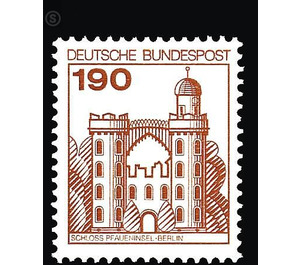Postage stamp: castles and palaces - Germany / Federal Republic of Germany 1977 - 190 Pfennig
Theme: Architecture
| Country | Germany / Federal Republic of Germany |
| Issue Date | 1977 |
| Face Value | 190.00 |
| Color | orange |
| Perforation | K 14 |
| Printing Type | Lithography |
| Stamp Type | Postage stamp |
| Item Type | Stamp |
| Chronological Issue Number | 808 |
| Chronological Chapter | GER-BRD |
| SID | 673858 |
| In 48 Wishlists | |
A new series of permanent rolling press with depictions of German castles and palaces replaces the roller-type brand series "Accident Prevention". The postage stamps of 40 and 190 Pfennig appearing as additional values in this series with the inscription Deutsche Bundespost are published at the same time and in the same motif as the inscription Deutsche Bundespost Berlin; the first two values were issued on January 13, 1977. The peacock island, a popular tourist destination of Berlin, located - within the administrative district Zehlendorf the city of Berlin (West) - between Wannsee and Kladow in the Havel. In 1685 the Great Elector gave the island, at that time called "Rabbitwerder", to Johann Kunckel, who made ruby glass there. Kunckel emigrated to Sweden in 1688, after the death of his patron. 1793 Frederick William II acquired the island and had for himself and Wilhelmine Encke, the future Countess Lichtenau, of the master carpenter Brendel build a half-timbered castle, which was clad by nailed boards with sandstone sand coating (replaced in recent times by concrete cladding). The model for the building is said to have been a sketch of the Countess, inspired by the memory of a ruined Italian castle. The castle Peacock Island, artfully executed in a romantic ruin style, is located in well-kept parks, which are today a nature reserve. The two towers of the building are connected by a walkway bridge (originally made of wood, replaced in 1807 by an iron bridge, an early product of the Berlin iron foundry). The precious interior of the castle with objects of old Berlin craftsmanship is preserved. Also noteworthy are also the Meierei, which was also built in ruins by Brendel, and the cavalier house built by Andreas Ludwig Krüger, which Schinkel redesigned in 1824 using the façade of a late-Gothic Gdansk patrician house. Friedrich Wilhelm III., Who liked to visit the island with Queen Louise, built a palm house and set up a menagerie. Theodor Fontane wrote: »Peacock Island! Like a fairy tale, a picture of my childhood rises before me. "Some visitors to the island and the castle will still feel that way today. (Text: excerpts from the texts of the German Castle Association e.V. Braubach - Dr. W. Avenarius)


